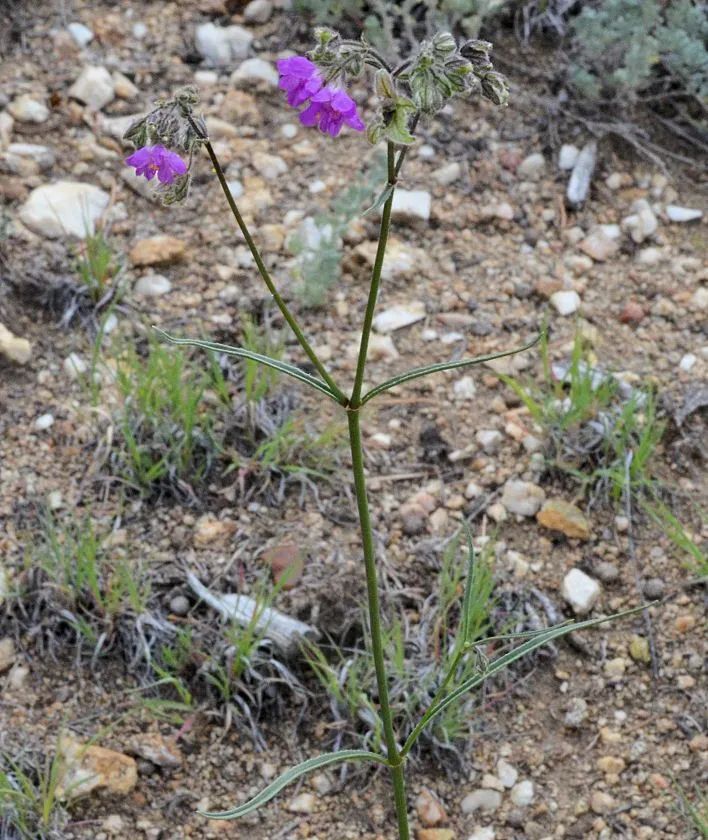
Author: (Pursh) Heimerl
Bibliography: Annuaire Conserv. Jard. Bot. Genève 5: 186 (1901)
Year: 1901
Status: accepted
Rank: species
Genus: Mirabilis
Vegetable: False
Observations: CS. Canada to M. Mexico
The Narrowleaf four o’clock, scientifically known as Mirabilis linearis, is a fascinating and resilient species within the Nyctaginaceae family. This plant is notable for its adaptability, found thriving in diverse environments from Canada down to mid-Mexico, showcasing a remarkable range that speaks to its hardiness and ecological versatility.
Mirabilis linearis is distinguished by its uniquely narrow leaves, which set it apart visually from other members of its genus. The plant’s common name, “Narrowleaf four o’clock,” highlights this characteristic feature. The leaves are long and slender, creating an elegant and streamlined appearance that adds to its appeal both in natural habitats and in cultivated gardens.
This species was first formally described and classified in 1901 by the botanist Heimerl in the “Annuaire Conserv. Jard. Bot. Genève”. The classification by Heimerl was an adaptation of earlier work by Pursh, recognizing the distinctive traits and broad distribution of Mirabilis linearis.
The Narrowleaf four o’clock typically blooms in the late afternoon or early evening, a behavior that has afforded the Mirabilis genus its common name of “four o’clock.” The flowers of Mirabilis linearis are small but striking, often presenting in shades of pink or magenta, which stand in vivid contrast to the green of their surroundings. These blooms not only add beauty but also play a crucial role in supporting pollinators such as moths and bees, which are active during the evening and early morning hours.
An essential player in its ecosystem, Mirabilis linearis often occupies open, well-drained places like prairies, rocky slopes, and dry meadows. Its adaptability to various soil types and conditions makes it a valuable species for conservation and ecological restoration projects, as well as a novel choice for gardeners looking to introduce hardy and low-maintenance plants into their landscapes.
In summary, the Narrowleaf four o’clock (Mirabilis linearis) is a striking and versatile plant, contributing significantly to the ecosystems it inhabits. From Canada to mid-Mexico, its presence enriches natural landscapes while inviting pollinators and providing visual interest. Described initially in the early 20th century, Mirabilis linearis continues to be appreciated for its ecological contributions and its unique, narrow-leaved beauty.
Eng: four o’clock, linearleaf four-o’clock, narrowleaf four o’clock, narrowleaf four-o’clock, narrow-leaved four-o’clock, linear-leaved four-o’clock, linear-leaved umbrellawort, narrow-leaved umbrellawort
Fra: nyctage à feuilles linéaires
En: Narrowleaf four o’clock, NARROW-LEAF FOUR-O’CLOCK, NARROWLEAF FOUR O CLOCK, Linearleaf four-o’clock, Narrowleaf four-o’clock, Four o’clock, Narrow-leaved four-o’clock, Linear-leaved four-o’clock, Linear-leaved umbrellawort, Narrow-leaved umbrellawort
Fr: Nyctage à feuilles linéaires
© copyright of the Board of Trustees of the Royal Botanic Gardens, Kew.
Taken May 23, 2004 by EOL − Robert Sivinski (cc-by-nc)
Taken Aug 6, 2015 by EOL − Barry Breckling (cc-by-nc-sa)
Taken Aug 6, 2015 by EOL − Barry Breckling (cc-by-nc-sa)
Taken Aug 6, 2015 by EOL − Barry Breckling (cc-by-nc-sa)
Taken Nov 13, 2013 by EOL − Ben VanderWeide (cc-by-nc)
Taken May 16, 2020 by Zeke Ellis (cc-by-sa)
Taken Aug 6, 2015 by EOL − Barry Breckling (cc-by-nc-sa)
Taken Dec 7, 2015 by EOL − Bob O’Kennon (cc-by-nc)
Taken Dec 7, 2015 by EOL − Bob O’Kennon (cc-by-nc)
Taken Dec 7, 2015 by EOL − Bob O’Kennon (cc-by-nc)
Taken Aug 15, 2015 by EOL − timraven (cc-by-nc)
Taken Aug 6, 2015 by EOL − Barry Breckling (cc-by-nc-sa)
Growth habit>: Subshrub, Forb/herb
Family: Myrtaceae Author: (F.Muell.) K.D.Hill & L.A.S.Johnson Bibliography: Telopea 6: 402 (1995) Year: 1995 Status:…
Family: Rubiaceae Author: Pierre ex A.Froehner Bibliography: Notizbl. Bot. Gart. Berlin-Dahlem 1: 237 (1897) Year:…
Family: Sapindaceae Author: Koidz. Bibliography: J. Coll. Sci. Imp. Univ. Tokyo 32(1): 38 (1911) Year:…
Family: Asteraceae Author: A.Gray Bibliography: Pacif. Railr. Rep.: 107 (1857) Year: 1857 Status: accepted Rank:…
Family: Fabaceae Author: Medik. Bibliography: Vorles. Churpfälz. Phys.-Ökon. Ges. 2: 398 (1787) Year: 1787 Status:…
Family: Aspleniaceae Author: (Cav.) Alston Bibliography: Bull. Misc. Inform. Kew 1932: 309 (1932) Year: 1932…